Rumble: Statia
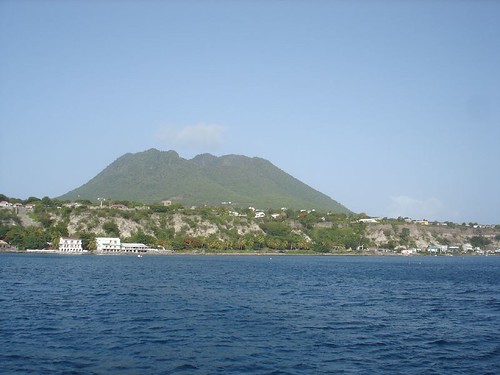
We had a lovely 35 miles sail from St.Barts to St.Eustatius (or Statia for short), in a broad reach, averaging 7 to 8 knots in a 25 knot wind.
The Dutch settlers arrived here in 1636 and set up sugar and tobacco plantations, but it was the trade which made the island flourish in the eighteenth century. At that time, over 3,500 ships would visit Statia every year, trading in anything the world traded in, then. Slaves, gold, silk, embroideries, weapons, you name it. For a while it was the commercial center of the Caribbean. Even nations at war would trade with eachother here, with one selling to the Statian traders and the enemy buying from the Statians.
By mistake, Statia was the first ever to give an official canon salute to a rebel American ship in 1776, thus indirectly recognizing the United States as a souvereign state. The English were not amused and it is said this salute to an American ship contributed to the English-Dutch war, during which Admiral Rodney occupied and plundered the island. An amusing anecdote was that he could not find much gold, but observed the Dutch-Jewish settlers sure held a lot of funerals. On Rodney's orders, one of the coffins was opened and they found it was full of gold and valuables: the settlers were burying their valuables. Rodney confiscated all of the treasures on his personal account, and was almost court-martialed for this theft, were it not that at that time, he won a sea battle near Les Saintes, off Guadeloupe. And he was pardoned for his theft.
When he exiled the Jewish settlers to neighbouring St.Kitts, he got suspicous again and had the coats of the prisoners examined. Once again, he found their coats were stuffed with gold...
There is only one main village on Statia: Oranjestad, whose lower town used to be the main trading post of the Caribbean, before it eroded and was washed away by hurricanes. In the pictures, you clearly see the dominant volcano, Upper Oranjestad and the lower town, below the cliff. Some walls of the old town can still be seen underwater, just 20-30 meters from the shore, making it an excellent diving and snorkeling area.
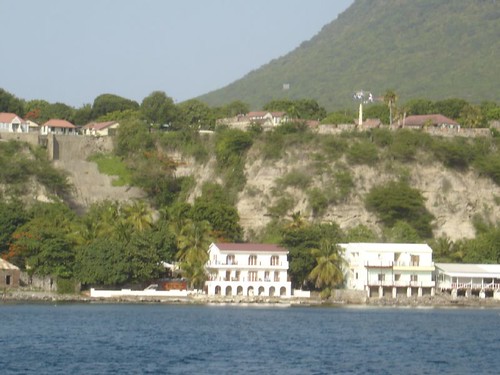
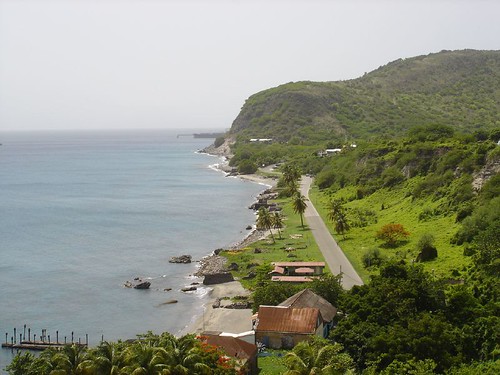
 Statia is off the beaten track for the tourists. Most come here for the diving, but for the rest, there is not much to do. It is a very laid back island. Very, very laid back. The first evening we were here, we asked which fresh fish they had, and the answer was: "None. All is frozen". We did not think much of it, until the next
Statia is off the beaten track for the tourists. Most come here for the diving, but for the rest, there is not much to do. It is a very laid back island. Very, very laid back. The first evening we were here, we asked which fresh fish they had, and the answer was: "None. All is frozen". We did not think much of it, until the next 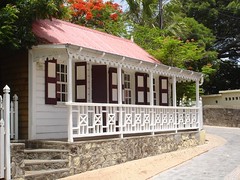 evening, we asked for fresh fish in another restaurant. Once again, the answer was: "None, all frozen". "But how come", we asked, "there is plenty of fish in the ocean here?". The expat waiter sighed and asked "How long have you been on the island, sir?". "Two days". "And in those two days, have you seen any of the fishermen on the water?", the waiter asked. "No", we said. "Right", was the answer, "To fish means to
evening, we asked for fresh fish in another restaurant. Once again, the answer was: "None, all frozen". "But how come", we asked, "there is plenty of fish in the ocean here?". The expat waiter sighed and asked "How long have you been on the island, sir?". "Two days". "And in those two days, have you seen any of the fishermen on the water?", the waiter asked. "No", we said. "Right", was the answer, "To fish means to  work. There is a saying here: 'If you see someone working in Statia, he ain't from here'. So rather than fishing, the people here prefer to import their fish frozen from St.Martin.". Go figure.
work. There is a saying here: 'If you see someone working in Statia, he ain't from here'. So rather than fishing, the people here prefer to import their fish frozen from St.Martin.". Go figure.
And somewhere this attitude reflected on the island as a whole. In a positive way: there is no crime, people just go about their business, they are friendly (the more for us, as we speak Dutch!). But also in a negative way: What could have been made into a nice marina, the harbour was just a pile of rocks and a short pier for the tugboats working on the oil tankers. Once you step off the pier, you see rubbish and junk everywhere. People said plastic bags are the island's state flower, as you used to see them flying off the trees everywhere. Once again, a pity.. An island paradise with a lot of junk. Still you could see some beautiful houses. In the end, every island in the Caribbean has its own charm.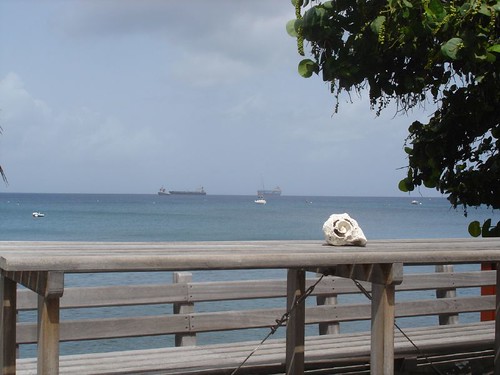
The Dutch settlers arrived here in 1636 and set up sugar and tobacco plantations, but it was the trade which made the island flourish in the eighteenth century. At that time, over 3,500 ships would visit Statia every year, trading in anything the world traded in, then. Slaves, gold, silk, embroideries, weapons, you name it. For a while it was the commercial center of the Caribbean. Even nations at war would trade with eachother here, with one selling to the Statian traders and the enemy buying from the Statians.
By mistake, Statia was the first ever to give an official canon salute to a rebel American ship in 1776, thus indirectly recognizing the United States as a souvereign state. The English were not amused and it is said this salute to an American ship contributed to the English-Dutch war, during which Admiral Rodney occupied and plundered the island. An amusing anecdote was that he could not find much gold, but observed the Dutch-Jewish settlers sure held a lot of funerals. On Rodney's orders, one of the coffins was opened and they found it was full of gold and valuables: the settlers were burying their valuables. Rodney confiscated all of the treasures on his personal account, and was almost court-martialed for this theft, were it not that at that time, he won a sea battle near Les Saintes, off Guadeloupe. And he was pardoned for his theft.
When he exiled the Jewish settlers to neighbouring St.Kitts, he got suspicous again and had the coats of the prisoners examined. Once again, he found their coats were stuffed with gold...
There is only one main village on Statia: Oranjestad, whose lower town used to be the main trading post of the Caribbean, before it eroded and was washed away by hurricanes. In the pictures, you clearly see the dominant volcano, Upper Oranjestad and the lower town, below the cliff. Some walls of the old town can still be seen underwater, just 20-30 meters from the shore, making it an excellent diving and snorkeling area.


 Statia is off the beaten track for the tourists. Most come here for the diving, but for the rest, there is not much to do. It is a very laid back island. Very, very laid back. The first evening we were here, we asked which fresh fish they had, and the answer was: "None. All is frozen". We did not think much of it, until the next
Statia is off the beaten track for the tourists. Most come here for the diving, but for the rest, there is not much to do. It is a very laid back island. Very, very laid back. The first evening we were here, we asked which fresh fish they had, and the answer was: "None. All is frozen". We did not think much of it, until the next  evening, we asked for fresh fish in another restaurant. Once again, the answer was: "None, all frozen". "But how come", we asked, "there is plenty of fish in the ocean here?". The expat waiter sighed and asked "How long have you been on the island, sir?". "Two days". "And in those two days, have you seen any of the fishermen on the water?", the waiter asked. "No", we said. "Right", was the answer, "To fish means to
evening, we asked for fresh fish in another restaurant. Once again, the answer was: "None, all frozen". "But how come", we asked, "there is plenty of fish in the ocean here?". The expat waiter sighed and asked "How long have you been on the island, sir?". "Two days". "And in those two days, have you seen any of the fishermen on the water?", the waiter asked. "No", we said. "Right", was the answer, "To fish means to  work. There is a saying here: 'If you see someone working in Statia, he ain't from here'. So rather than fishing, the people here prefer to import their fish frozen from St.Martin.". Go figure.
work. There is a saying here: 'If you see someone working in Statia, he ain't from here'. So rather than fishing, the people here prefer to import their fish frozen from St.Martin.". Go figure.And somewhere this attitude reflected on the island as a whole. In a positive way: there is no crime, people just go about their business, they are friendly (the more for us, as we speak Dutch!). But also in a negative way: What could have been made into a nice marina, the harbour was just a pile of rocks and a short pier for the tugboats working on the oil tankers. Once you step off the pier, you see rubbish and junk everywhere. People said plastic bags are the island's state flower, as you used to see them flying off the trees everywhere. Once again, a pity.. An island paradise with a lot of junk. Still you could see some beautiful houses. In the end, every island in the Caribbean has its own charm.

 Peter. Flemish, European, aid worker, expeditioner, sailor, traveller, husband, father, friend, nutcase. Not necessarily in that order.
Peter. Flemish, European, aid worker, expeditioner, sailor, traveller, husband, father, friend, nutcase. Not necessarily in that order.
0 comments:
Post a Comment